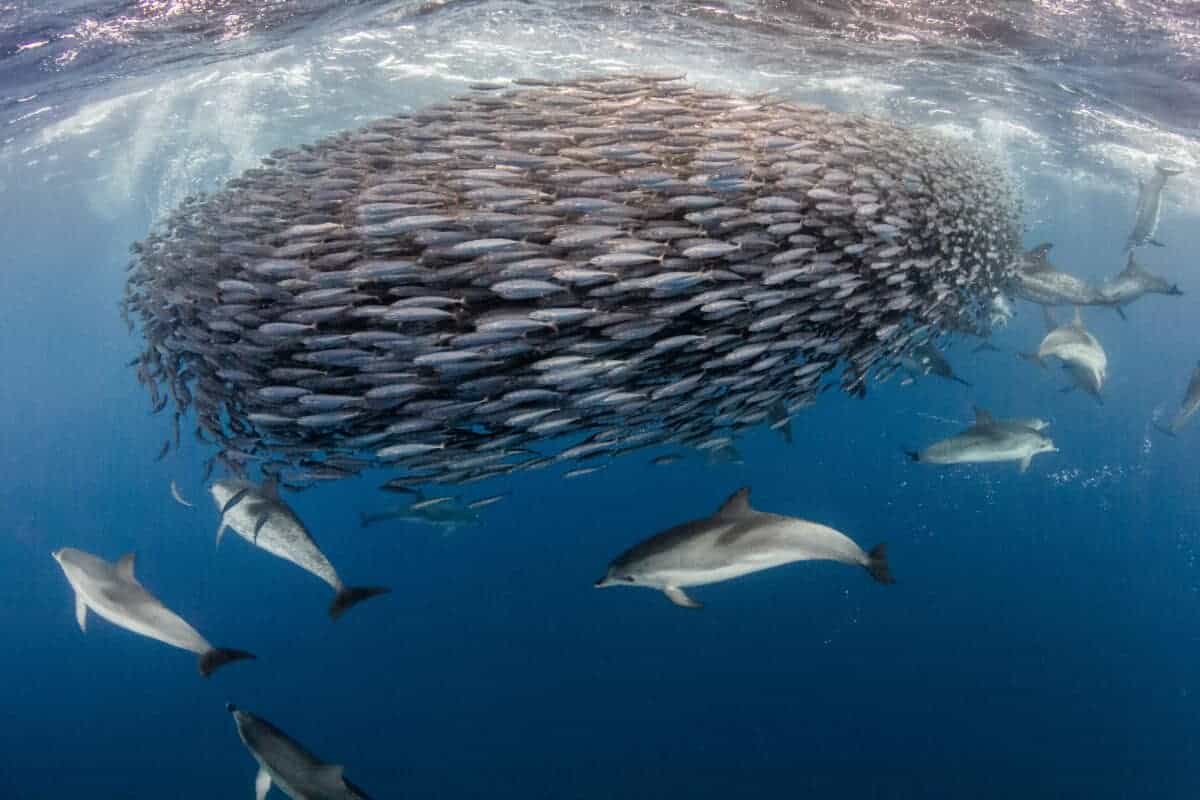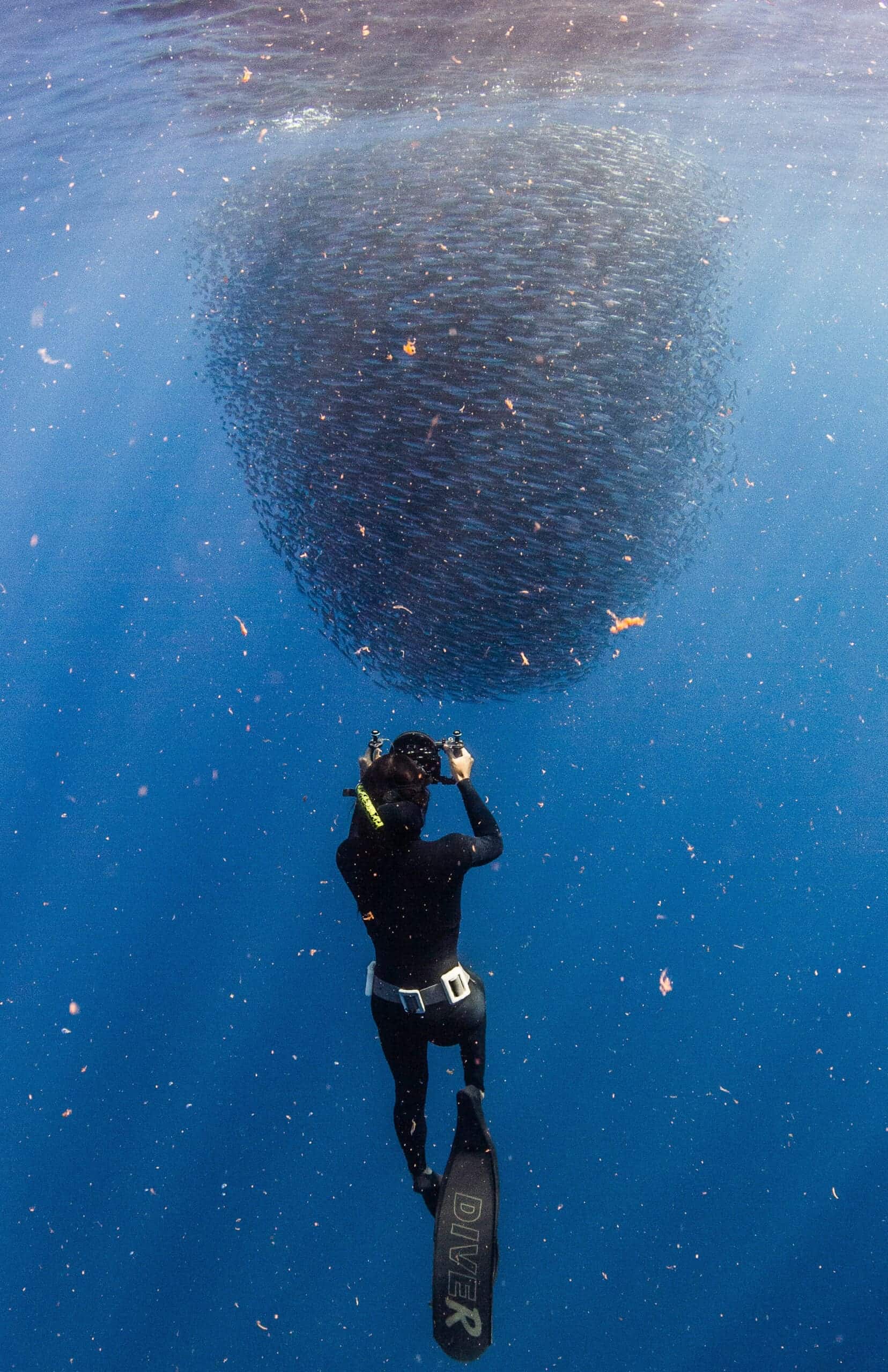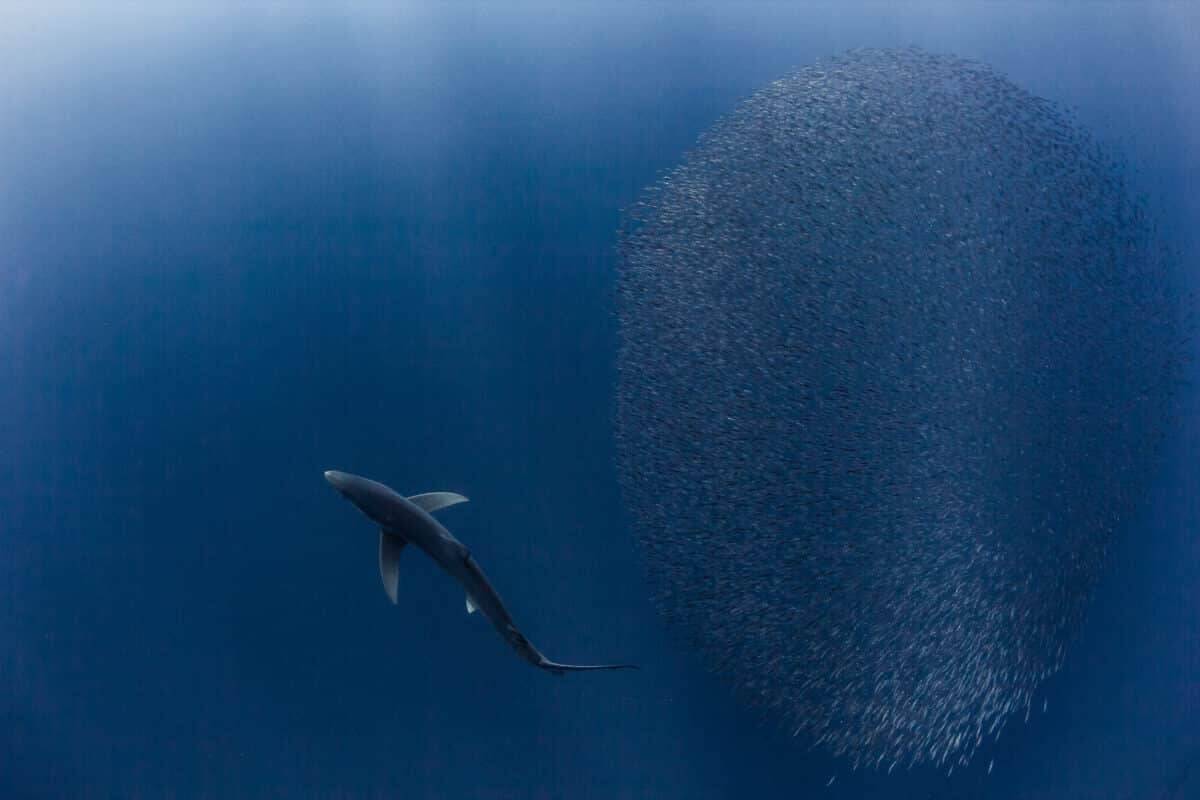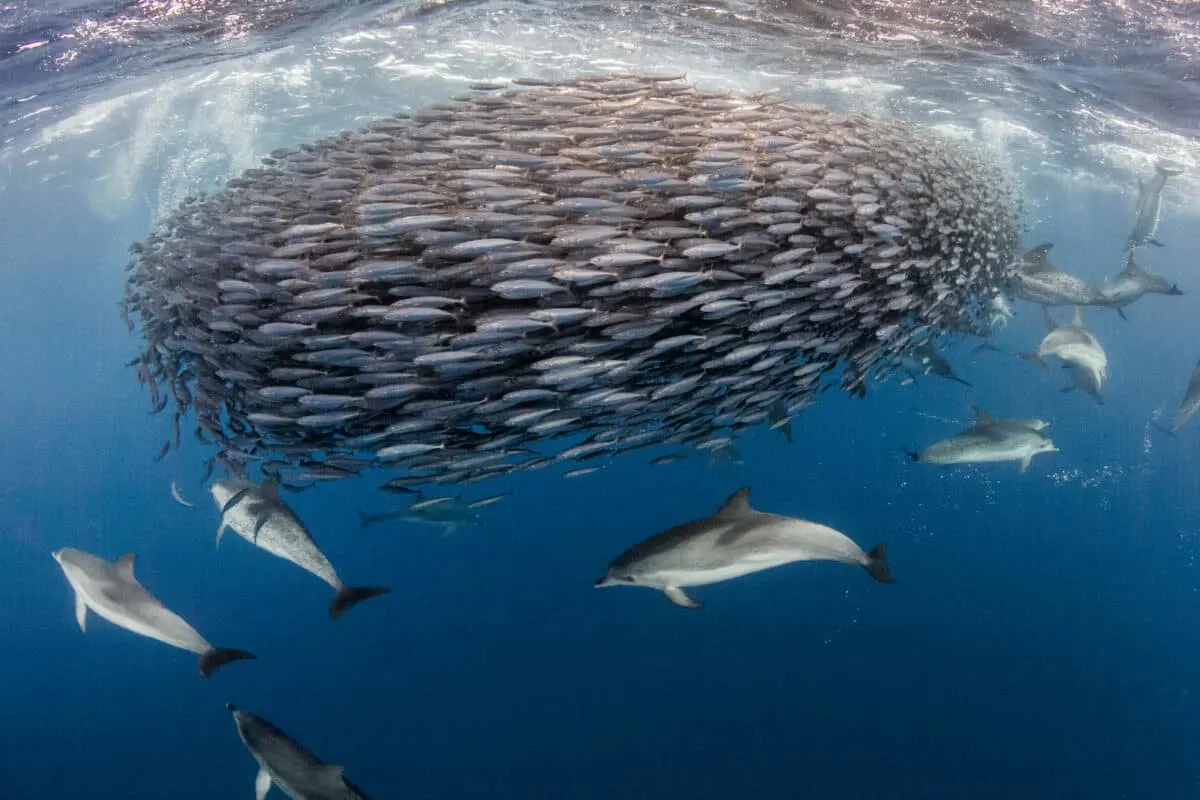What are Baitballs?
Baitballs are fascinating natural feeding frenzies where predators corral a shoal of fish together in a tight ball. Creating their buffet, as these tight formations make it easier for predators to feed on large schools of fish. You will often see different predator species working together to push the fish up from below. Then, when the fish are trapped near the surface, seabirds swoop in and take advantage, picking off one fish at a time.
Let’s dive deeper into the exhilarating experience of encountering a baitball!

Seabirds’ Role in Locating Baitballs
Baitballs occur when bait fish get pushed up from deep waters in the open ocean, but also occur against continental shelves and seamounts. The fact that this event takes place in the open ocean, makes finding and chasing down this incredible sight particularly challenging and unpredictable.
Luckily, seabirds are there to help find baitballs! These birds are attracted to the surface feeding activity from miles away, giving away the location of the action taking place.
Underwater photographers and documentary filmmakers travel across the world trying to witness and capture these extraordinary feeding frenzies out at sea.
Global Hotspots for Baitball Events
There are some special places on earth where at certain times of the year the chances of witnessing this type of feeding event is extremely high. Some of these places include the Sardine Run in South Africa which happens between May and July. As well as the Striped Marlin Run off the coast of Baja California, Mexico during November and December. Where striped marlin, sea lions, and other predators feed on massive schools of sardines and mackerel.
These two events are well documented, but few know that in the middle of the Atlantic Ocean, in the waters of the Azores archipelago, baitballs occur relatively consistently too!
The Azores – A Prime Location

The Azores are situated on top of the Mid-Atlantic ridge and are surrounded by extremely deep waters. The steep underwater cliffs surrounding the island cause the dominant currents to push nutrient-rich waters from the deep and toward the surface, in an event called upwelling. The ideal conditions for huge baitballs to form!
In the Azores, you’ll find massive groups of different types of small, pelagic fish like blue jack mackerel, chub mackerel, and longspine snipefish. These fish gather in huge shoals, drawing in a crowd of predators including dolphins, sharks, seabirds, whales, and tunas.
The abundance of both predators and prey sets the stage for epic feeding events like baitballs to occur. Once you have chased down a baitball on the horizon, getting into the water to witness the predators feeding on these huge shoals is the next major challenge. Many pieces need to fall into place before the action is stable enough to form a static ball.
The Dynamics of a Static Baitball

A static baitball means that the school of fish is attacked by enough hungry predators to go into a state of panic. The fish then stay in one place instead of swimming away, turning tight circles around each other. They do this to try and confuse predators while searching for safety in numbers but unknowingly, they just make it easier for the predators to take large mouthfuls of fish at a time.
Watch Baitball Action Captured By Martijn Schouten
Predator Techniques and Interactions
Here in the Azores, different predators use different hunting techniques to feed on the baitball.
Fish
Tunas like yellowfin, big eye, bluefin, and skipjack tuna, launch highspeed attacks on the silvery fish from below often diminishing a baitball in minutes with only scales left behind.
Dolphins
Dolphins, mainly short-beaked common dolphins and Atlantic spotted dolphins, use communication and work together to herd the fish. To achieve this, they use their bodies and blow bubbles around the shoal of fish. Once the fish are tightly packed, the dolphins come through the baitball to snatch up their prey.
Sharks
Blue sharks and whales such as sei, humpback, fin, and Bryde’s whales, are solitary animals or travel in small groups or pairs. On their own they don’t stand a chance to form a baitball, so they take advantage of the dolphins and/or tuna’s hunting techniques. Letting them do all the hard work before they take their fill!
Birds
The birds, mainly yellow-legged gulls and shearwaters, also take advantage by attacking the fish from above. The gulls have to wait until the fish comes right to the surface since they can’t dive. The shearwaters on the other hand, can dive down to -10 meters or more to pick up one mackerel at a time when the baitball is deeper.
Seeing these birds swim underwater chasing after the fish is a very special sight. Whale sharks, when they are around, are capable of herding a school of baitfish on their own. They simply use their big bodies to push the fish up to the surface, and when they are trapped the whale shark uses its huge mouth to suck in as much prey as possible.
Challenges and Strategies in Finding Baitballs
To find baitballs in the middle of the Atlantic Ocean you will need a combination of factors. Time on the water, knowledge of the ocean and the movements of animals, intel from other operators on the water, a good pair of eyes looking for birds feeding on the horizon, and of course, some luck as well! These searches for feeding events normally happen bright and early in the mornings, or late afternoons.
Although you can find baitballs any time of the day, anybody who goes to sea often will tell you most activity happens during the first and last hours of sunlight. Before we go to sea we always gather as much information as possible about where to find the key elements for a successful day on the water. We get this information from fishermen, whale-watching boats, and vigias – land-based spotters that help locate whales and dolphins among other marine animals for the whale watchers.
The Thrill of Witnessing This Phenomenon

Once we have pieced together all the available information, we head out to pinpoint the activity. Time is of the essence when tracking down baitballs and so is getting into the water, as the action generally only lasts a couple of minutes.
Most of the time, the first thing you will see once you get into the water is bubbles, fish scales, and animals coming from all directions. No doubt this will get your heart racing! Then when you get closer you start seeing the silvery fish tightly packed in a ball, with fear in their eyes as they swim circles around each other while predators come from all sides to feed on them. From here on all you can do is be in awe of the spectacle that is unfolding in front of your eyes!
Final Thoughts
The Azores archipelago is a prime, yet lesser-known, location for witnessing the incredible phenomenon of baitballs. This natural spectacle, where a myriad of marine predators converge to feast on densely packed shoals of fish, offers a unique and thrilling experience for underwater photographers, documentary filmmakers, and nature enthusiasts alike.
Martijn Schouten’s experience in chasing baitballs in the Azores encapsulates the essence of adventure and discovery, reminding us of the endless wonders that our oceans hold and the need to cherish and protect these natural phenomena for generations to come.
If you enjoyed this article, read more on:
- A Tale of Whale Migration in Both Hemispheres
- The Largest School of Fish Ever Witnessed
- The fish that can predict Tsunamis
- Top 10 Cutest Fish in the World
Join our Forum for free today!

- Surprise Hippo Attack on Three Lions - July 21, 2024
- USA’s Best Wildlife Conservation Success Stories - July 14, 2024
- The Incredible Bird with Sunflower Eyes - July 13, 2024



